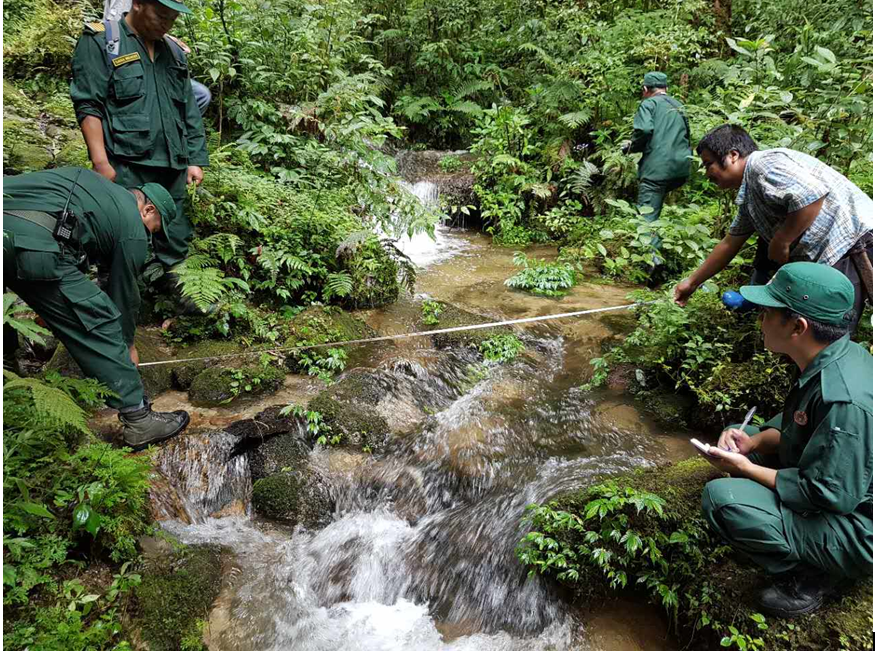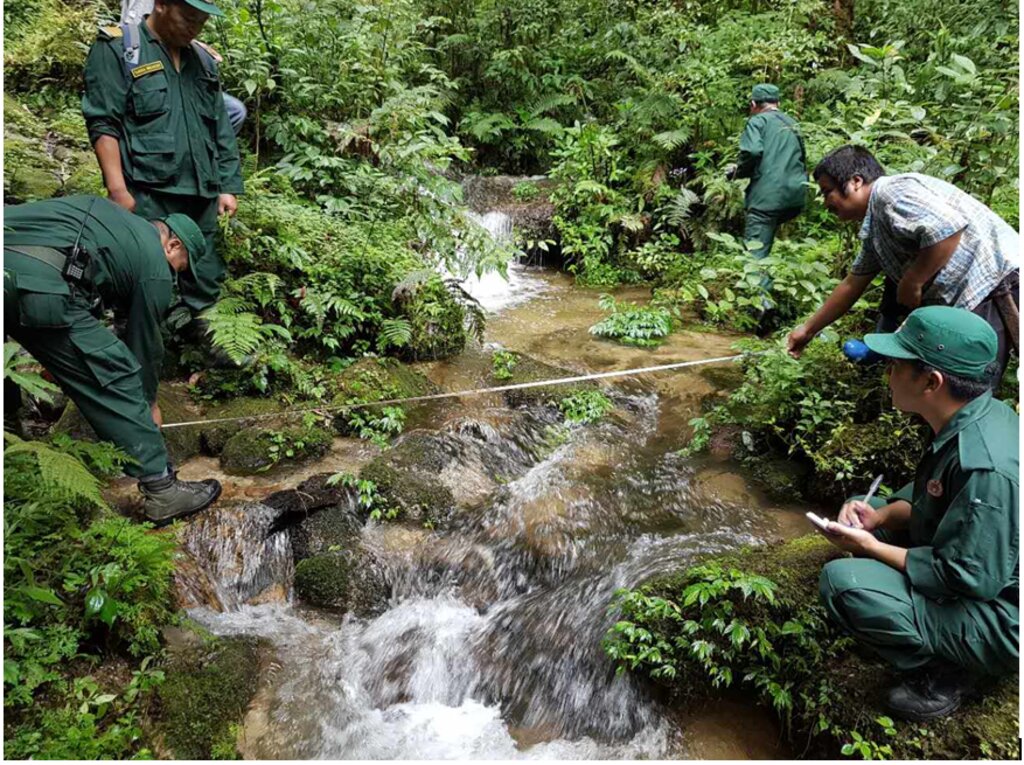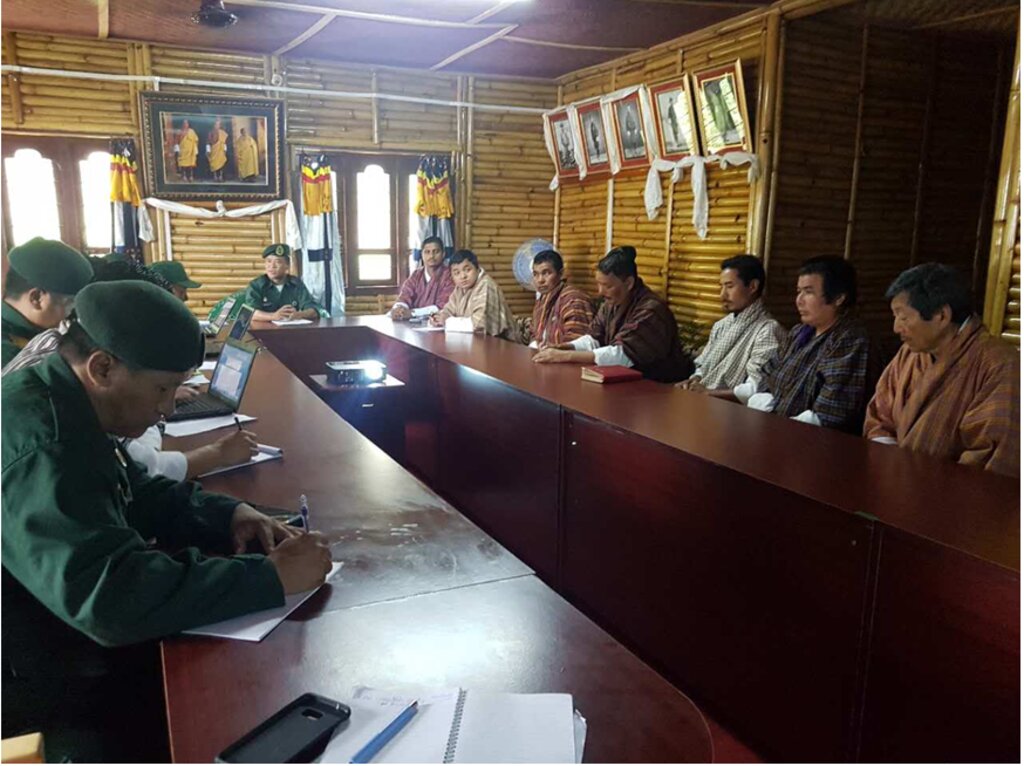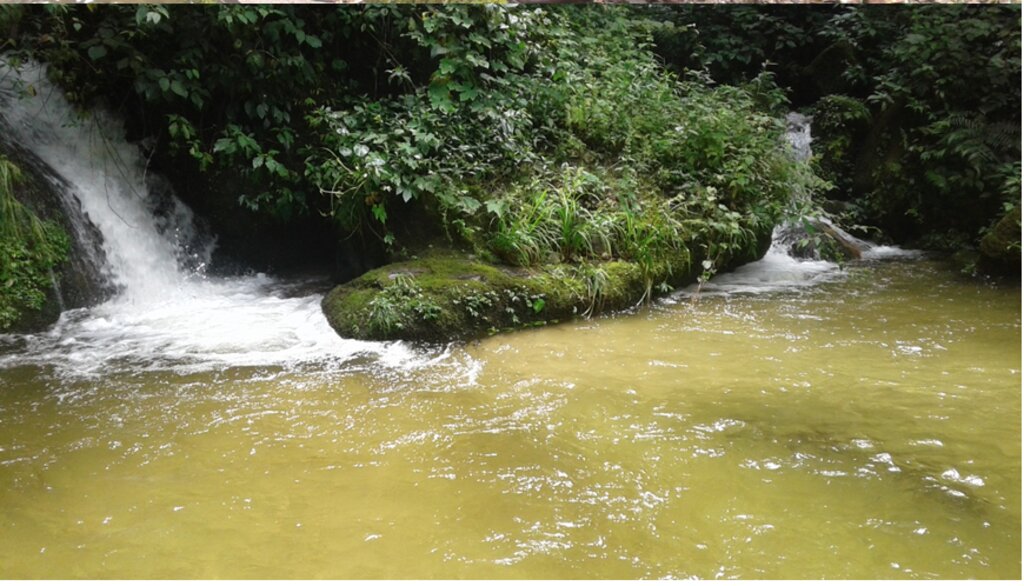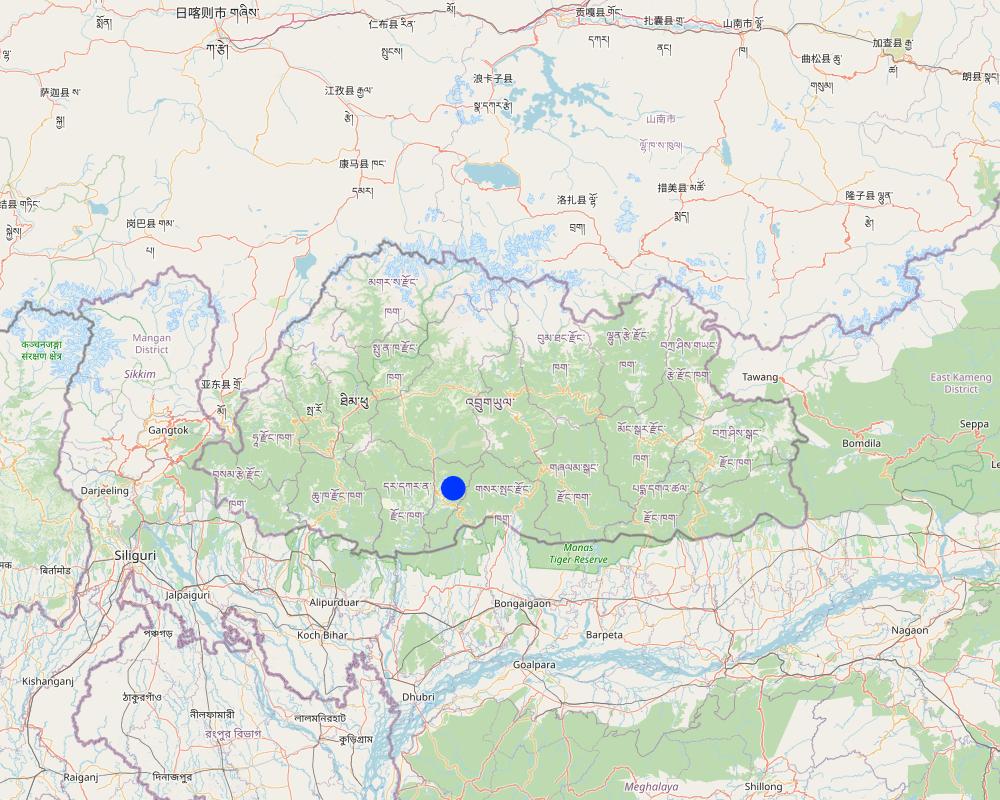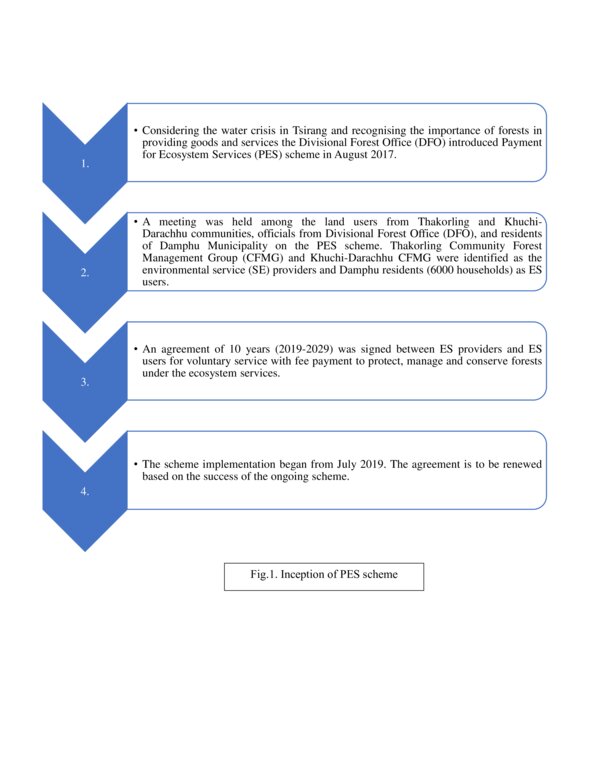Sustaining Drinking Water through Payment for Environment Services (PES) [Bután]
- Creación:
- Actualización:
- Compilador: Tshering Yangzom
- Editor: Haka Drukpa
- Revisores: William Critchley, Rima Mekdaschi Studer
PES
approaches_6862 - Bután
- Resumen completo en PDF
- Resumen completo en PDF para imprimir
- Resumen completo en el navegador
- Resumen completo (sin formato)
- Sustaining Drinking Water through Payment for Environment Services (PES): 24 de enero de 2024 (inactive)
- Sustaining Drinking Water through Payment for Environment Services (PES): 31 de enero de 2024 (inactive)
- Sustaining Drinking Water through Payment for Environment Services (PES): 30 de mayo de 2024 (public)
Visualizar secciones
Expandir todo Colapsar todos1. Información general
1.2 Detalles de contacto de las personas de referencia e instituciones involucradas en la evaluación y la documentación del Enfoque
Persona(s) de referencia clave/s
Usuario de la tierra:
Tamang Lhasang
17765702
Thakorling, Tsirang Dzongkhag
Bután
Usuario de la tierra:
Tamang Dawa
17831694
Thakorling, Tsirang Dzongkhag
Bután
Usuario de la tierra:
Sunwar Ganesh
17804899
Thakorling, Tsirang Dzongkhag
Bután
Usuario de la tierra:
Ghalley Basant Kumar
17714794
Thakorling, Tsirang Dzongkhag
Bután
Usuario de la tierra:
Rai Bal Bir
17638940
Thakorling, Tsirang Dzongkhag
Bután
Nombre del proyecto que facilitó la documentación/ evaluación del Enfoque (si fuera relevante)
Sustainable Land Management Project, Bhutan (SLMP)Nombre de la(s) institución(es) que facilitaron la documentación/ evaluación del Enfoque si fuera relevante)
National Soil Services Center, Department of Agric (National Soil Services Center, Department of Agric) - Bután1.3 Condiciones referidas al uso de datos documentados mediante WOCAT
¿Cuándo se compilaron los datos (en el campo)?
18/07/2023
El compilador y la/s persona(s) de referencia claves aceptan las condiciones acerca del uso de los datos documentados mediante WOCAT :
Sí
2. Descripción del Enfoque MST
2.1 Breve descripción del Enfoque
This approach compensates land users annually for taking care of a water source and its surroundings. The source is being looked after by two groups of environmental service providers and water is supplied to seven gewogs and Damphu Municipality in the Tsirang Dzongkhag.
2.2 Descripción detallada del Enfoque MST
Descripción detallada del Enfoque MST:
Due to shortages of good quality water, and the need for protection of the watershed to improve quality and quantity, a “Payment for Ecosystem Services” (PES) contractual agreement has been put into place between providers of the services and users. This strategy's primary goal is to maintain the availability of drinking water for places experiencing shortages. The agreement is between the Thakhorling Community Forest Management Group (CFMG) referred to as the "Primary Provider" and Khuchi-Darachhu CFMG as the "Secondary Provider" of environmental services (ES), and the Drinking Water users of Damphu referred to as “Users” of the drinking water source. Official government intermediaries administer the payment for environmental services (PES) mechanism to ensure that it is implemented successfully between the providers and the user.
Under the agreement,
•The ES Providers pledge that a buffer strip of 100 meters shall be maintained on both sides of the stream, where no vegetation or trees can be removed or harvested, and no grazing is permitted. This helps ensure proper recharging of spring sources as well as improving water quality.
•The ES Providers agree to plant native species annually to rehabilitate degraded watersheds.
•The ES Primary Provider commits to guarding the entire watershed from illegal extraction and overgrazing to improve vegetation cover and to ensure the continuous flow of springs.
•The ES Primary Provider promises to clear stream channels every four months to facilitate continuous flow of water.
•The ES Users take responsibility to pay for all the activities undertaken by ES Providers for the protection of the watershed.
•The ES Providers (both primary and secondary) will receive (approx.) US $2700 per year from the Users. The payment is included in the monthly water bill, collected by the Municipal Authority of Damphu, and released to the ES Providers annually. However, in case of increase in water users from current numbers (6000), an additional fee collected will also be released to ES Providers as an additional incentive.
•In the event the ES Provider fails to carry out the activities as agreed, the Dzongkhag Administration has the authority to retain the PES fee of the failed activity and release the fees for other activities.
This agreement is valid for a period of ten years from July 2019 until June 2029 and may be renewed or extended based on the consensus of the parties. To execute the agreement, two water user groups were formed with a chair and committee, and these created tight by-laws. Once every three months, the chairman inspects the water source's cleaning process – for which the workers receive compensation. The land users work in groups to preserve the water source and the surroundings, and they are paid annually. Each year, the groups must plant trees on an acre of land (0.4 ha) close to the water supply.
Monitoring and evaluation of the PES are conducted twice a year - in June and in December- by the officials from Dzongkhag, Municipal, Thromde and Forest Division. After a successful evaluation, they sign a form which is essential to ensure the annual budget for the PES.
Since the water source is in Thakorling, the land users' permission was crucial to supply water to other locations. Many initially opposed the notion of sharing the water source because they believed it would one day result in a water shortage in their own region. But consultations helped them change their minds. Officials gave them assurances that should a water crisis emerge in the Thakorling area, the municipality and Thromde vowed to provide them with water at any cost. Almost everyone accepted the agreement though there are still a small number of people who disagree.
2.3 Fotos del Enfoque
2.5 País/ región/ lugares donde el Enfoque fue aplicado
País:
Bután
Región/ Estado/ Provincia:
Tsirang
Especifique más el lugar :
Thakorling village
Comentarios:
The water source is in Paw Khola, but the compiler was unable to travel there because of the distance and heavy rain. For Paw Khola, which also has a Community Forest, the geocoordinates that were shown on the Google map were used.
Map
×2.6 Fechas de inicio y conclusión del Enfoque
Indique año del inicio:
2019
Año de conclusión (si el Enfoque ya no se aplica):
2029
Comentarios:
This agreement shall be valid for a period of ten years starting from 1st July 2019 till 30th June 2029 and may be renewed or extended based on the consensus of the parties with prior notice of six months before the date of expiry of the agreement.
2.7 Tipo de Enfoque
- proyecto/ basado en un programa
2.8 Propósitos/ objetivos principales del Enfoque
To protect the water source and maintain continuous supply of clean water to 7 geogs, Damphu Municipality and other institutions.
To protect the water source and distribute water to areas where there is a scarcity.
2.9 Condiciones que facilitan o impiden la implementación de la/s Tecnología/s aplicadas bajo el Enfoque
normas y valores sociales/ culturales/ religiosos
- facilitan
The land users were willing to share the water source with the other users.
- impiden
Some land users were against this idea as they thought they might face water scarcity in the community in the future.
disponibilidad/ acceso a recursos y servicios financieros
- facilitan
The funds required to implement this plan were all provided by the government.
entorno institucional
- facilitan
Groups were formed to protect water source.
colaboración/ coordinación de actores
- facilitan
The land users worked collectively when they had to clean and carry out maintenance works.
marco de trabajo legal (tenencia de tierra, derechos de uso de tierra y agua)
- facilitan
PES group formed for ten years with agreement signed between Parties (Service Providers and Service Users).
políticas
- facilitan
Section 47 of Forest Act 2023 provides support for the establishment of PES.
mercados (para comprar insumos, vender productos) y precios
- facilitan
Market and price is determined by the agreement signed between Service Providers and Service Users.
carga de trabajo, disponibilidad de mano de obra
- facilitan
Workload is eased by the presence of other land users (availability of manpower).
3. Participación y roles de las partes interesadas involucradas
3.1 Partes interesadas involucradas en el Enfoque y sus roles
- usuarios locales de tierras/ comunidades locales
Land users
Land users formed groups to protect, manage and conserve forests under the ecosystem services.
- Thromde, Municipal and Divisional Forest Office.
Thromde, Municipal and Divisional Forest Office.
Conduct PES meetings, allocate budget and monitor and evaluate the activities carried out by the land users.
3.2 Involucramiento de los usuarios locales de tierras/ comunidades locales en las distintas fases del Enfoque
| Involucramiento de los usuarios locales de tierras/ comunidades locales | Especifique quién se involucró y describa las actividades | |
|---|---|---|
| iniciación/ motivación | ninguno | Considering the water crisis in Tsirang and recognising the importance of forests in providing goods and services the Divisional Forest Office (DFO) introduced Payment for Ecosystem Services (PES) scheme in August 2017. |
| planificación | interactivo | Both land users and government officials were involved while establishing the approach. |
| implementación | interactivo | ES providers, Thakorling Community Forest Management Group (CFMG) and Khuchi-Darachhu CFMG protect, manage and conserve forests under the ecosystem services. ES users pay for all the activities undertaken by ES providers. Divisional Forest Office looks after the overall conduct of activities in the PES scheme. |
| monitoreo y evaluación | interactivo | Divisional Forest Office and land users were involved. |
3.3 Flujograma (si estuviera disponible)
3.4 La toma de decisiones en la selección de Tecnología(s) MST
Las decisiones para la selección de la/s Tecnología(s) fueron tomadas:
- Divisional Forest Office and Damphu Municipality in consultation with the land users.
Explique:
There water was abundant in Thakorling and Khuchi-Darachhu so the Divisional Forest Office (DFO) introduced the PES scheme. The technologies under the approach were decided via consultations among the ES providers and users and DFO.
Especifique las bases que sustentaron la toma de decisiones:
- la evaluación de conocimiento MST bien documentado (la toma de decisiones se basa en evidencia)
- la experiencia personal y opiniones (no documentadas)
4. Apoyo técnico, fortalecimiento institucional y gestión del conocimiento
4.1 Construcción de capacidades / capacitación
¿Se proporcionó la capacitación a usuarios de tierras/ otras partes interesadas?
No
4.2 Servicio de asesoría
¿Los usuarios de tierras tienen acceso a un servicio de asesoría?
Sí
Especifique si servicio proporcionado se realizó:
- en los campos de los usuarios de tierras
Describa/ comentarios:
The ES providers have to carry out certain regular activities like cleaning the stream, afforestation, guarding community forest against illegal extraction of forest resources, limiting the number of cattle members, and maintaining sanitation and hygiene, among others. The land users have access to advisory services mostly from the Divisional Forest Office.
4.3 Fortalecimiento institucional (desarrollo institucional)
¿Se establecieron o fortalecieron instituciones mediante el Enfoque?
- sí, mucho
Especifique el nivel o los niveles en los que se fortalecieron o establecieron las instituciones:
- local
Describa la institución, roles y responsabilidades, miembros, etc.
The two community forest management groups identified as the ES providers have a chairperson, a secretary, and an accountant each (appointed from among the land users). The land users jointly carry out activities like cleaning the stream, afforestation, guarding community forest against illegal extraction of forest resources, limiting the number of cattle members, and maintaining sanitation and hygiene, among others.
Especifique el tipo de apoyo:
- financiero
Proporcione detalles adicionales:
The finances come from the water users annually thereby resulting in the generation of income for the land users/ ES providers.
4.4 Monitoreo y evaluación
¿El monitoreo y la evaluación forman parte del Enfoque?
Sí
Si respondió que sí, ¿la documentación se utilizará para monitoreo y evaluación?
No
4.5 Investigación
¿La investigación formó parte del Enfoque?
No
5. Financiamiento y apoyo material externo
5.1 Presupuesto anual para el componente MST del Enfoque
Si no se conoce el presupuesto anual preciso, indique el rango:
- < 2,000
Comentarios (ej. fuentes principales de financiamiento/ donantes principales):
Environmental services users.
5.2 Apoyo financiero/material proporcionado a los usuarios de tierras
¿Los usuarios de tierras recibieron financiamiento/ apoyo material para implementar la Tecnología/ Tecnologías? :
Sí
Si respondió sí, especifique el tipo o los tipos de apoyo, condiciones y proveedor(es) :
Finacial support from the environmental services users.
5.3 Subsidios para insumos específicos (incluyendo mano de obra)
- ninguno
Si la mano de obra de usuarios de tierras fue un insumo sustancial, ¿fue:
- voluntario?
5.4 Crédito
¿Se proporcionó crédito bajo el Enfoque para actividades MST?
No
5.5 Otros incentivos o instrumentos
¿Se usaron otros incentivos o instrumentos para promover la implementación de Tecnologías MST?
No
6. Análisis de impacto y comentarios de conclusión
6.1 Impactos del Enfoque
¿El Enfoque empoderó a los usuarios locales de tierras, mejoró el involucramiento de las partes interesadas?
- No
- Sí, un poco
- Sí, moderadamente
- Sí, mucho
All the land users works collectively in groups to protect, manage and conserve forests
¿El Enfoque ayudó a los usuarios de tierras a implementar y mantener Tecnologías MST?
- No
- Sí, un poco
- Sí, moderadamente
- Sí, mucho
The land users carry out SLM activities such as afforestation, guarding community forest against illegal extraction of forest resources, limiting the number of cattle members, and maintaining sanitation and hygiene, among others.
¿El Enfoque mejoró la coordinación e implementación efectiva en costos de MST?
- No
- Sí, un poco
- Sí, moderadamente
- Sí, mucho
The land users work collectively towards the shared goal of forest protection via funds from the ES users.
¿El Enfoque movilizó/mejoró el acceso a recursos financieros para implementar MST?
- No
- Sí, un poco
- Sí, moderadamente
- Sí, mucho
The approach has improved access to financial resources via funds from the ES users.
¿El Enfoque mejoró el conocimiento y capacidades de los usuarios para implementar MST?
- No
- Sí, un poco
- Sí, moderadamente
- Sí, mucho
The land users are mostly engaged in small but important SLM activities such as afforestation, guarding community forest against illegal extraction of forest resources, limiting the number of cattle members, and so on.
¿El Enfoque construyó/ fortaleció instituciones, colaboración entre partes interesadas?
- No
- Sí, un poco
- Sí, moderadamente
- Sí, mucho
All the land users work collectectively in groups to manage and conserve forests.
¿El Enfoque mitigó conflictos?
- No
- Sí, un poco
- Sí, moderadamente
- Sí, mucho
Water crisis has been solved.
¿El Enfoque empoderó a grupos en desventaja social y económica?
- No
- Sí, un poco
- Sí, moderadamente
- Sí, mucho
The land users from various backgrounds are part of ES providers.
¿El Enfoque mejoró la equidad de género y empoderó a las mujeres y niñas?
- No
- Sí, un poco
- Sí, moderadamente
- Sí, mucho
Both men and women are in the groups of ES providers.
¿El Enfoque alentó a jóvenes/ la siguiente generación de usuarios de tierras a involucrarse con MST?
- No
- Sí, un poco
- Sí, moderadamente
- Sí, mucho
The approach is focused on forest management and conservation and it positively showcases the benefits of managing and protecting the forests.
¿El Enfoque resultó en mejor seguridad alimentaria/ mejoró la nutrición?
- No
- Sí, un poco
- Sí, moderadamente
- Sí, mucho
ES providers get some amount from the ES users and this amount increases the access to financial resources. Improved access to financial resources in turn increases the access to improved food or nutrition.
¿El Enfoque llevó a un acceso mejorado a tierra y saneamiento?
- No
- Sí, un poco
- Sí, moderadamente
- Sí, mucho
ES users have access to clean and continuous water.
¿El Enfoque mejoró la capacidad de los usuarios de tierras a adaptarse a los cambios climáticos/ extemos y mitigar desastres relacionados al clima?
- No
- Sí, un poco
- Sí, moderadamente
- Sí, mucho
This approach encourages afforestation, reduced overgrazing or clearing of vegetation which can indirectly be related to fighting climate change in small ways.
¿El Enfoque llevó a oportunidades de empleo, ingresos?
- No
- Sí, un poco
- Sí, moderadamente
- Sí, mucho
The land users are able to generate income through their environmental services to the ES users.
6.2 Motivación principal del usuario de la tierra para implementar MST
- pagos/ subsidios
The land users receive money per year in order to protect the water source.
- mitigación de conflicto
Water scarcity in some places has reduced.
6.3 Sostenibilidad de las actividades del Enfoque
¿Pueden los usuarios de tierras sostener lo que se implementó mediante el Enfoque (sin apoyo externo)?
- sí
Si respondió que sí, describa cómo:
PES scheme is sustainable without external support as long as the ES providers keep on providing environmental services and the ES users pay for the services. Also, this scheme promotes the different practices of protecting, managing and conserving forests such as afforestation, guarding against illegal extraction of forest resources, and limiting the number of cattle which are all sustainable practices.
6.4 Fortalezas/ ventajas del Enfoque
| Fuerzas/ ventajas/ oportunidades desde la perspectiva del usuario de la tierra |
|---|
| Improved access to financial resources. |
| Deeping of SLM knowledge of the land users because of different sustainable forest management practices carried out. |
| Sustainable PES scheme as the fund is generated by the ES users with no reliance on external funding. |
| Fuerzas/ ventajas/ oportunidades desde la perspectiva del compilador o de otra persona de referencia clave |
|---|
| Since the land users plant trees each year and have strict rules and regulations to protect the environment, it helps in environmental conservation. |
| Help preserve natural resources and educate the local people on how to protect the continuous flow of water from the sources. |
6.5 Debilidades/ desventajas del Enfoque y formas de sobreponerse a ellos
| Debilidades/ desventajas/ riesgos desde la perspectiva del usuario de la tierra | ¿Cómo sobreponerse a ellas? |
|---|---|
| Water shortage during winter season. | The land users have constructed water harvesting ponds. |
| Disagreements in the implementation of plans during the initial period. | Held meetings to clear the confusion and solve the disagreements. |
| Debilidades/ desventajas/ riesgos desde la perspectiva del compilador o de otra persona de referencia clave | ¿Cómo sobreponerse a ellas? |
|---|---|
| Dispute among the members. | Through discussions |
| Water crisis in the near future as the land users share water from a single source. | Protect the water source and use water wisely. |
7. Referencias y vínculos
7.1 Métodos/ fuentes de información
- entrevistas con usuarios de tierras
5 informants
7.3 Vínculos a la información relevante disponible en línea
Título/ descripción:
Protecting the water source of Damphu town through PES scheme
URL:
https://www.bbs.bt/news/?p=118173#:~:text=Beginning%20this%20month%2C%20the%20residents,forest%20of%20the%20two%20chiwogs.
Título/ descripción:
Payment for Environmental Services scheme established in Tsirang
URL:
https://www.facebook.com/search/top/?q=payment%20for%20environmental%20service%20established%20in%20Tsirang%202019
Vínculos y módulos
Expandir todo Colapsar todosVínculos
No hay vínculos
Módulos
No se hallaron módulos


